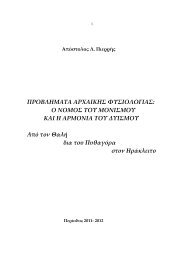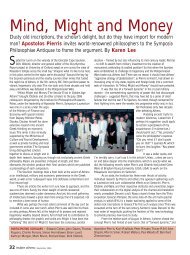APPENDIX C΄ ON DEPILATION: BODY COSMETICS IN CLASSICAL ...
APPENDIX C΄ ON DEPILATION: BODY COSMETICS IN CLASSICAL ...
APPENDIX C΄ ON DEPILATION: BODY COSMETICS IN CLASSICAL ...
Create successful ePaper yourself
Turn your PDF publications into a flip-book with our unique Google optimized e-Paper software.
576 <strong>APPENDIX</strong> <strong>C΄</strong><br />
colour or in the same colour-dimension. In fact we can probably best<br />
approximate the meaning of appleÂÚÎÓfi˜ by rendering it as deep(er) hue.<br />
Thus Theophrastus, De Causis Plant. 316.3: ¬Ù·Ó ôÚ¯ˆÓÙ·È appleÂÚο-<br />
˙Ô˘Û·È Ôî ‚fiÙÚ˘Â˜; Hist. Pl. 9.11.7: ¬Ù·Ó ôÚÙÈ appleÂÚο˙ÂÈ ì ÛÙ·Ê˘Ï‹;<br />
Chaeremon, 12 [Mϋller, Fr.H.Gr.] of grapes just beginning to ripen:<br />
çappleÒÚ· ôÎÚ·ÈÛÈ appleÂÚο˙Ô˘Û· ÔåÓ¿Óı·È˜; v. also Homer, Odyssey, η,<br />
123-6, where the ñappleÔappleÂÚο˙Ô˘Û·È ÛÙ·Ê˘Ï·› are just one degree<br />
removed from being ùÌʷΘ, i.e. totally unripe, with still their flower.<br />
The compound is explained by Hesychius, s.v. ñappleÔappleÂÚο˙Ô˘ÛÈØ ÌÂÙ·-<br />
‚¿ÏÏÔ˘ÛÈÓ (leg. pro ηٷ‚¿ÏÏÔ˘ÛÈÓ) âÎ ÙÔÜ ùÌÊ·ÎÔ˜, ηd ñappleÔÌÂÏ·›-<br />
ÓÔÓÙ·È. Besides applying as the word does to even a slight deepening<br />
of the hue of grapes (themselves having various colour-shades), it is<br />
used equally in reference to olives: Geoponika 9.12.2, Anthologia Gr.<br />
VI, 102; Pollux I, 61 …ηd âÏ·›·˜ appleÂÚÎÓɘ, meaning the ripe olive;<br />
idem., V, 67 (speaking of a species of dog): å‰b· Ï·Ág ηd ʇÛȘ, Ùe<br />
ÌbÓ ¯ÚáÌ· âapple›appleÂÚÎÓÔ˜ (öÛÙÈ ‰b ÙÔÜÙÔ appleÂÚÎÓɘ âÏ·›·˜ Ùe Âr‰Ô˜, ÔûÙÂ<br />
ùÌÊ·ÎÔ˜ öÙÈ, ÔûÙ õ‰Ë ÌÂÏ·ÈÓÔ̤Ó˘), ̤ÁÂıÔ˜ Ôé ̤Á·˜ etc. This is<br />
a very significant passage; it is clear here that appleÂÚÎÓfi˜ signifies rather a<br />
slight mellowing of the green olive, before the process of real<br />
darkening has begun. The word enjoyed a wider application. Thus<br />
Porphyry, Vita Pyth. 44: Âå ‰b ηd àÓıÔÜÓÙÔ˜ âÓ Ùˇá ‚Ï·ÛÙ¿ÓÂÈÓ ÙÔÜ<br />
΢¿ÌÔ˘ Ï·‚ÒÓ ÙȘ appleÂÚο˙ÔÓÙÔ˜ ÙÔÜ ôÓıÔ˘˜, etc. When Aristotle<br />
speaks of the appleÂÚÎÓe˜ ö¯È˜ (Mirab. 846b18; cf. Nicander, Theriaca,<br />
129), he probably means a speckled, or darkly spotted viper; and<br />
maybe the same sense is appropriate to the appleÂÚÎÓÔd å¯ı‡Â˜ in<br />
Marcellus Sidetes (M. Schneider, Comment. Philologicae quibus O.<br />
Ribbecio … congatulantur discipuli, Leipzig 1888, p. 115). For<br />
Hesychius s.v. appleÂÚÎÓfiÓ has ÌÂÏ·ÓfiÓ (clearly in the sense of dark,<br />
deep); appleÔÈΛÏÔÓ (and s.v. appleÚÂÎÓfiÓØ appleÔÈÎÈÏfi¯ÚÔÔÓØ âÏ·ÊÚfiÓ (?)); s.v.<br />
appleÂÚο˙ÂÈØ ÌÂÏ·Ó›˙ÂÈØ appleÔÈΛÏÏÂÈØ j appleÂapple·›ÓÂÙ·È (a concise description<br />
of the whole field of meanings); and s.v. appleÂÚη›ÓÂÈÓØ ‰È·appleÔÈΛÏÏÂÛı·ÈØ<br />
ηd Ùa ¬ÌÔÈ· (v. also s.v. âÌappleÂÚο˙Ô˘Û·ÓØ ñappleÔı¿ÏÏÔ˘Û·ÓØ ÌÂÏ·Ó›˙Ô˘-<br />
Û·Ó). It is interesting to note that the word was metaphorically used to<br />
signalize the first shades, the first sign of beard on a youth’s face. Thus<br />
Callimachus, Hymn. in Lavacrum Pallad. 75-6: TÂÈÚÂÛ›·˜ ‰’ öÙÈ<br />
ÌáÓÔ˜ ±Ì· Î˘Û›Ó, ôÚÙÈ Á¤ÓÂÈ· / appleÂÚο˙ˆÓ etc., where the scholiast<br />
notes: appleÂÚο˙ˆÓØ ÌÂÏ·ÈÓfiÌÂÓÔ˜ (in the sense explained) ñapplee Ùɘ<br />
ʇÛˆ˜ ÙáÓ ÙÚȯáÓ. And in an epigram by Philippus commenting










